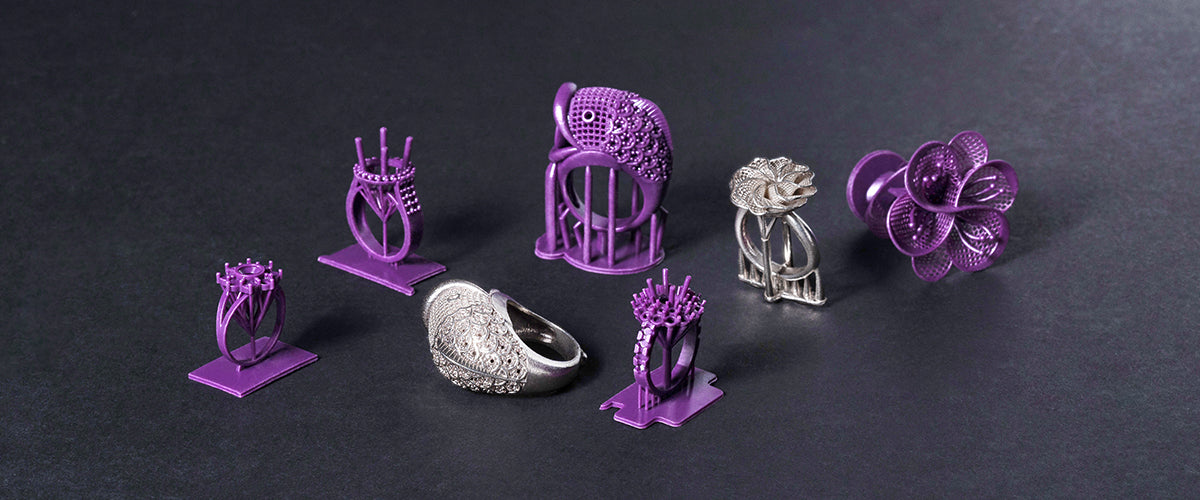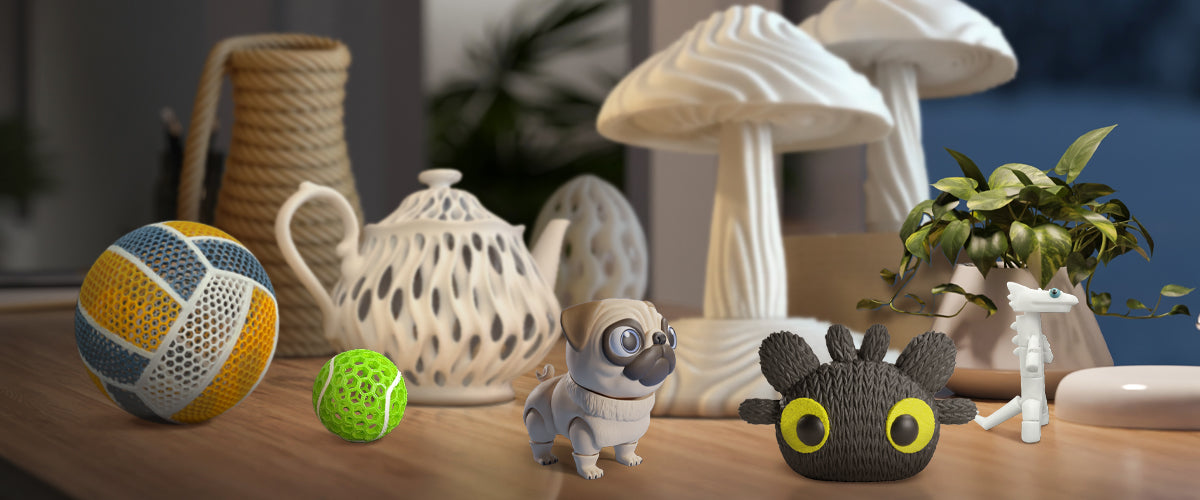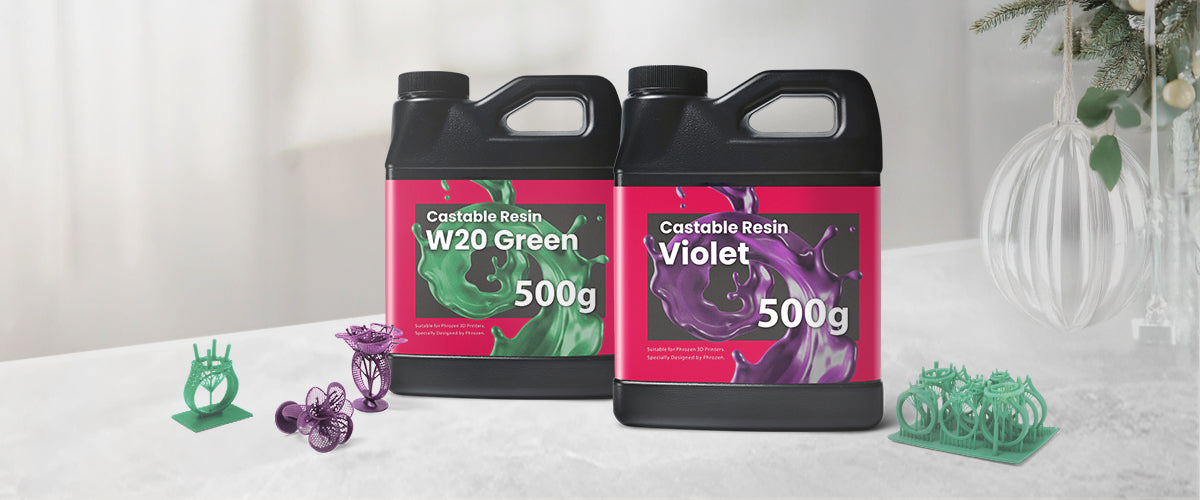Jewelry casting has undergone a major transformation over the past two decades. What was once a fully manual process has become a blend of traditional craftsmanship and digital technology. Hand-carved wax models are still respected and widely used, but 3D printing and CAD design have introduced faster, more precise workflows—and a new generation of materials.
At the center of this shift are two main options for creating castable models: traditional wax and modern castable resin. Each has its strengths, and the better choice depends on how you work, what you’re making, and the tools in your setup.
Whether you're new to jewelry casting or refining an established workflow, understanding how wax and resin compare will help you make more informed decisions. In this guide, we’ll look at how both materials behave during printing, casting, and finishing—so you can find the approach that fits your work best.
Material Differences That Actually Matter
Let’s begin with the most basic difference—what wax and resin actually are, and how that affects their use in jewelry casting.
Traditional wax has been used for centuries. It's often hand-carved or molded into shape and is valued for its smooth surface and easy burnout. Wax burns cleanly, leaving almost no residue behind, which makes it ideal for casting metals, especially those that require higher temperatures like platinum. When used properly, wax offers a beautiful, reliable base for casting that feels familiar to many jewelers who have been in the industry for years.
Castable resin, on the other hand, is a relatively newer material designed specifically for 3D printing. It's a liquid polymer that solidifies when exposed to light inside a 3D printer. Unlike wax, resin isn’t carved by hand. Instead, it’s shaped digitally using CAD software and printed layer by layer in extremely fine detail. The result is a model that can be just as clean and precise—sometimes even more so—than wax.
One of the biggest differences you’ll notice is how the two materials behave during the casting process. Wax melts out cleanly and quickly when heated, while resin needs a longer burnout cycle and more careful temperature control to ensure it leaves no ash behind. However, modern castable resins have improved a lot. Some, like those used by jewelers today, burn almost as cleanly as wax and can be used for complex or highly detailed designs without issue.
Another thing to consider is surface texture. Wax tends to have a naturally smooth finish, which is perfect for pieces that need to be polished or refined after casting. Resin can also achieve a smooth finish, especially when printed at high resolutions, but depending on the printer settings, it may require more post-processing.
If you're using castable resin and want to understand exactly how it turns into metal, the full process is easier than you might think. From removing supports to burnout and finishing, each step plays a role in getting that final polished result. If you're new to this method or just curious about how it all works in practice, we recommend checking out this detailed walkthrough of how to cast metal jewelry using a 3D printed resin model. It features step-by-step instructions using Phrozen’s W20 Green resin and tools like the Sonic Saber, with tips from one of Taiwan’s leading jewelry makers.
Now that we’ve covered the material basics, let’s look at how each one fits into different workflows and use cases.
How Your Workflow Affects the Material You Use
Every jewelry maker has a slightly different way of working. Some rely heavily on handcrafting techniques and prefer to shape each model manually. Others have moved to digital design tools like CAD software and now depend on 3D printers to bring their pieces to life. Your workflow plays a big role in deciding whether wax or resin is a better choice for you.
If you’re someone who enjoys the hands-on process of carving wax or using wax injection molds, traditional wax might still be the most natural fit. It allows for a very tactile design process, where changes can be made directly on the material. Many jewelers find this method satisfying and intuitive, especially for custom, one-off pieces where the design evolves as they work.
However, this approach also comes with limitations. Carving wax takes time and requires steady hands and years of practice. Making duplicates of the same piece means creating molds or repeating the same manual steps. If you need to make several of the same design or produce pieces quickly, wax can slow you down.
Now let’s say you’re working in a more digital environment. Maybe you design your pieces in CAD, then move to a 3D printer to create your models. In this case, castable resin is probably the better option. With resin, you can print your design directly from the file, and it will look exactly as you planned it. There’s no carving, no shaping by hand—just a direct path from screen to castable model.
This kind of workflow makes it much easier to scale your production. You can print multiple models at once, save time on manual labor, and ensure each piece is identical to the last. For jewelry businesses that deal with batch production, this kind of efficiency can make a big difference. It’s also useful for prototyping and testing designs before committing to final versions.
Of course, many jewelers fall somewhere in between. You might do most of your design work in CAD but still prefer to finish or tweak your models by hand. Or you might only use 3D printing for certain types of pieces. Either way, understanding how resin and wax fit into your process can help you decide when and where to use each one.
Common Concerns About Resin (and What’s True Today)
When jewelers think about switching from wax to resin, a few common concerns tend to come up. Many of these are based on early versions of castable resins, which weren’t always reliable. But things have changed a lot in recent years, and modern resin technology now solves most of the issues that used to make jewelers hesitant.
One of the biggest questions is about burnout. People often ask: does resin leave residue in the mold? The truth is, older resins did, and that caused problems like porosity or rough surfaces in the final cast. But today, most high-quality resins are formulated to burn cleanly when used with the right burnout schedule. For example, Phrozen’s W20 Green resin is specifically designed for jewelry casting. It contains 20% wax and has an ash content as low as 0.0–0.1%. That means it leaves almost no residue behind and works well with investments like Plasticast, Ultravest Maxx, and Prestige Optima.
Another concern is warping or shrinkage. Early resin prints could sometimes distort, especially during curing. But resins like Phrozen’s Castable Jewelry Violet are made to stay stable, even during long prints or detailed designs. This makes them a good option when you’re printing tiny prongs, intricate patterns, or engraved surfaces that need to stay sharp and true to your CAD model.
Surface finish is also something jewelers care about. Wax is naturally smooth, and resin can sometimes show layer lines depending on the printer settings. But with the right equipment and fine layer heights—like 0.05 mm or better—you can get crisp, clean prints with excellent surface quality. Phrozen resins are optimized for high-resolution LCD printers, meaning the level of detail is often sharper than what’s possible with hand-carved wax.
There’s also the issue of smell or fumes. Some resins used to have a strong odor, but modern low-odor formulas are much easier to work with. Phrozen’s resins are low-odor and safe to handle when used in well-ventilated spaces, especially when you follow proper safety steps like using gloves and washing prints with IPA.
In short, most of the concerns jewelers had about resin are no longer deal-breakers—if you’re using the right resin and following a proper workflow. With materials like W20 Green, W40 Orange, and Jewelry Violet, casting with resin can be just as clean, reliable, and accurate as using wax—sometimes even more so.
Real-World Scenarios: When Resin Wins, When Wax Still Works
To make this choice more practical, let’s look at a few different types of jewelers and how resin or wax fits into their day-to-day work.
Imagine someone like Josh. He runs a small but growing jewelry brand focused on minimalist designs—mostly rings and pendants with clean lines and geometric forms. Josh often sells the same few designs over and over, so he needs consistency. He also wants to speed up his process so he can handle more orders without sacrificing quality. In Josh’s case, using a 3D printer with castable resin makes perfect sense. Once he has his designs ready in CAD, he can print multiple models in one batch, knowing they’ll all come out identical. He doesn’t have to spend time carving each one, and he can cast them quickly and cleanly. For someone focused on repeatable, production-ready pieces, resin is an efficient and smart choice.
Now picture Mary. She’s a jewelry artist who specializes in unique, custom-made pieces. Each of her designs is one-of-a-kind—often inspired by nature, with lots of flowing curves, texture, and organic shapes. Mary enjoys the hands-on process of sculpting her ideas in wax. It gives her more freedom to improvise and adjust as she goes. Since she isn’t making large batches or working to tight deadlines, the extra time it takes to carve wax isn’t a problem. For Mary, the physical act of carving is part of her creativity. And when it comes time to cast, wax still gives her the clean, reliable results she needs—especially for more challenging metals or delicate forms. For artists like Mary, wax remains a powerful and flexible tool.
These two scenarios show that there’s no one-size-fits-all answer. Some jewelers thrive with the speed and precision of resin, especially if they’re scaling production. Others prefer the creative freedom and familiarity of wax, particularly for complex, handmade work. And many people do both, depending on the project.
Choosing What’s Best for Your Workflow
The choice between wax and resin doesn’t come down to which material is better—it comes down to which one fits you. Every jeweler works differently, and the best casting material is the one that complements your creative process, your tools, and the kind of jewelry you’re making.
If your background is in hand-carving or wax modeling, and you enjoy the control and flexibility that come with shaping each piece manually, wax might still be the right choice. It's tactile, it’s familiar, and it gives you the freedom to make real-time decisions as you sculpt. For one-of-a-kind pieces and artistic designs, wax remains a strong, reliable material.
But if your workflow is already digital—if you design in CAD, use a 3D printer, and prefer precision and repeatability—then resin might suit your needs better. It allows you to go directly from file to model, reducing production time and minimizing manual labor. Resin models are ideal when you need sharp details, tight tolerances, or multiple copies of the same design.
If you're already using a resin printer, exploring materials like Phrozen’s W20 Green or W40 Orange can help you strike the right balance between fine detail, clean burnout, and consistent results. These resins are made for casting metals like gold, silver, and brass, and are optimized to deliver smooth surfaces and stable prints—even for delicate parts like filigree or stone settings.
And for jewelers focused on precision over batch volume, a resin like Phrozen’s Jewelry Violet offers low shrinkage and crisp edges, making it a solid choice for smaller, highly detailed models. With modern materials and printers, it’s now possible to match—and sometimes surpass—the finish quality of wax, while speeding up the overall production process.
Curious about which 3D printer delivers the best results for jewelry work? One jeweler’s in-depth review of the Sonic Mini 8K shares how it handles ultra-fine detail, setup, and long-term performance. Read the full review here to see why high-resolution printing can make such a difference in casting quality.
So rather than picking a side, think about your goals. What are you designing? How fast do you need to deliver? Are you making one piece or twenty? When you answer those questions, the material choice often becomes clear.
Final Thoughts: Use What Works for You
Resin and wax aren’t enemies—they’re just different tools. Resin is great for speed, precision, and digital workflows. Wax still shines for hands-on sculpting and one-of-a-kind pieces.
If you're focused on repeatable results and already designing in CAD, modern castable resins—with clean burnout and low shrinkage—can seriously boost your efficiency. But if your creativity depends on carving by hand, wax may still feel like home.
In the end, the best material is the one that supports how you work. And if you're curious about resin, there's never been a better time to try—it’s faster, more reliable, and more accessible than ever.



